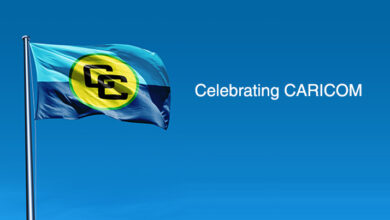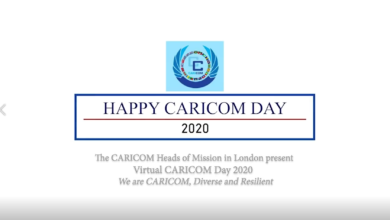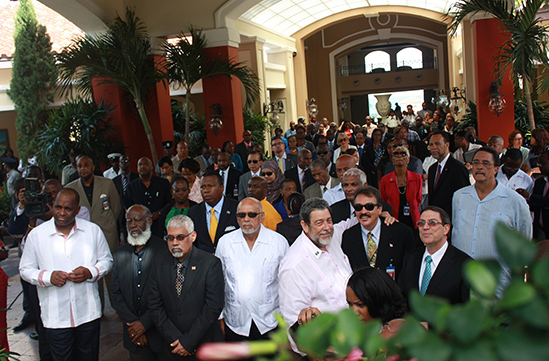Your Excellency the President of Guyana
Honourable Prime Minister
Members of Cabinet of Guyana
Members of the Diplomatic Corps
Distinguished Guests
Staff of the Secretariat
Representatives of the Media
Distinguished Ladies and Gentlemen
It is my very pleasant task as Secretary-General of the Caribbean Community (CARICOM) to welcome you on this CARICOM Day to this celebration of Caribbean unity – marking the 35th Anniversary of CARICOM.
Three days ago, some of us were fortunate to be at the site in Antigua and Barbuda where forty-three years ago, recognising the harsh reality that there was no place for individual small countries in the international arena and moreover, that the rich potential of these Caribbean countries could be fulfilled only through integration, the Chief Minister, the Honourable Vere Bird of Antigua and Barbuda, Premier, the Honourable Errol Barrow of Barbados and Premier, the Honourable Forbes Burnham of Guyana signed the Dickenson Bay Agreement.
That Agreement brought about the Caribbean Free Trade Association (CARIFTA) which with the signing of the Treaty of Chaguaramas on 4 July 1973, by Prime Ministers the Honourable Errol Barrow of Barbados, the Honourable Forbes Burnham of Guyana, the Honourable Michael Manley of Jamaica and the Honourable Eric Williams of Trinidad and Tobago became the Caribbean Community and Common Market. Today, we celebrate the anniversary of that event. The Community and Common Market has since evolved into the Caribbean Community including the Single Market and soon to be the Single Economy.
Along the way, the Founding Members were joined by the other countries currently comprising the Caribbean Community, now totalling 15 Member States, including Dutch-speaking Suriname and French-speaking Haiti, with a total population of approximately 15 million. Also joining the process as Associate Members, were the five territories of Anguilla, Bermuda, British Virgin Islands, Cayman Islands and the Turks and Caicos Islands.
Interestingly enough, a feature of the Community’s experience has been that each forward step has been met with significant pockets of doubt, hesitation and wariness.
In fact, it seems to be a favourite pastime of some to forecast the death of the movement and yet here we are, forty years after CARIFTA still together. This is a Community which today, can stand proudly as the longest existing integration movement among developing countries and second only to the European Union in longevity.
The simple reason for this state of affairs is that despite its limitations – and there are some even significant ones – the movement remains our best hope as a people, in a world where there is continuing marginalisation of small states such as ours in the global theatre. Indeed, the movement can say as Mark Twain did, reports of my demise have been greatly exaggerated!
Moreover, notwithstanding its creaks, cracks and strains, it is your movement, the people’s movement – in need of improvement yes – but deserving to be dumped and replaced with what, no! Indeed, as our Chairman said at the Opening Ceremony of the recently concluded Twenty-Ninth Meeting of the Conference of Heads of Government, “If CARICOM did not exist, we would have had to invent it.” The cost of Non-CARICOM is too high, even to contemplate.
It is instructive that even though two of those three states that were represented at Dickenson Bay, Barbados and Guyana, went on to Independence less than a year after that December signing, their visionary leaders kept the faith, knowing that their future lay in forging a lasting unity that would enable their people to prosper and their societies to enjoy sustained development. And this was years before globalisation, the internet, EPAs and 140 dollars a barrel oil prices. It is well said in the good book that where the leaders have no vision, the people will perish and to that I will add where the leaders have vision, the people can prosper.
What did those visionaries know then, that we do not know now? Were they alive today, would they have taken a different route? Have the fundamentals altered that much to deny the imperative of integration?
Some say that this yearning for Caribbean integration is built on sentimentality and nostalgia and has no place in the pragmatic world that we live in today. The reality is that that pragmatic world has no place for individual small nation states which do not possess the scale of economies to excite investment or encourage trade.
If there were any doubt about that, the recent Meeting in New York, USA with the movers and shakers of Wall Street should have disabused everyone of that notion. These pragmatic men and women of high finance made it quite clear that their interest in us stemmed from the Regional possibilities.
It is those possibilities which have fired the imagination of the Region’s leaders over the past 35 years and have prompted its peoples to urge the leaders to seek ever closer union. Our capacity to fashion actuality out of those possibilities depend in significant measure on how resolute our commitment is as a people, to the integration process. That depth and strength of commitment is indispensable as we seek to implement measures that will build the viable and prosperous societies that the people of this Community deserve.
For example, it is the vision of what is possible that has brought us our own matriculation and examination system administered by the Caribbean Examinations Council (CXC), now sought after outside the Community, the Pan-Caribbean Partnership Against HIV/AIDS (PANCAP), hailed as an international best practice by the United Nations, the Caribbean Court of Justice, (CCJ) and a much sought after voice and vote in the international arena.
And we cannot forget that acting together ensured that as far as moving thousands of people throughout the nine venue countries and security went, our hosting of the Cricket World Cup 2007 was an outstanding success. Regrettably, the performance of our team on the field did not match this! Those arrangements showed that as challenging as the geography, the differing levels of development, to name just two issues, may be, no challenge is insurmountable if the will and commitment of all the people are in sync.
This is fully recognised by our leaders who, in the Declaration of Dickenson Bay issued following the recently concluded 29th Meeting of the Conference of Heads of Government affirmed: “the continuing need to invest in the development of the human and other resources of the Community in the movement towards deeper integration.”
The Heads of Government in that document also recognised that much depends on the National Governments’ structures in support of the integration process and on the efficacy of their functioning and declared: “Our intention to strengthen national systems to advance implementation of Community decisions.”
Ladies and Gentlemen, in going forward what have these 35 years taught us if not that we do it better when we do it together. The lure of individuality is a siren song leading to the rocks of disintegration. The choir of integration may have different voices but all join to make a joyful if sometimes discordant, noise out of the same song sheet.
Together we will build the Single Economy, including the CARICOM Development Fund (CDF), together we will assist our youth through programmes such as those in education and health in becoming the ideal Caribbean
Person and together we will construct A Community for All. And in the words of the Declaration of Dickenson Bay, Heads of Government committed themselves to: “… use all means possible to galvanise the People of the Community as active participants in the integration process and embrace the media and other stakeholders as partners to accomplish this objective.”
Let us go forward therefore bearing in mind the words of the preamble to the Dickenson Bay Agreement and “SHARING a common determination to fulfil within the shortest possible time the hopes and aspirations of their peoples and of other Caribbean countries.”
It is that movement that Guyana has helped to give birth and shape and has played host to over the years. It is to that end that this evening in celebrating the history of our togetherness and its achievements that we raise our glasses and drink a toast to Caribbean integration and Guyana’s seminal role in the process.
I thank you




